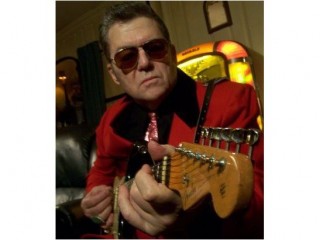
Harry Hepcat biography
Date of birth : -
Date of death : -
Birthplace : Columbia, South Carolina, U.S.
Nationality : American
Category : Arts and Entertainment
Last modified : 2011-11-30
Credited as : Singer, Rock and Roll musician, "Streakin' USA"
0 votes so far
Born sometime in the early 1940s, Harry Hepcat grew up in a house blasting with music. His grandfather, played trumpet with a band, and his mother, wanting to dance in a chorus line, took tap dancing lessons. Around this musical house, Harry's mother also sang along to old 78 rpm records. Unfortunately, Harry's father was sent to Europe to fight in WWII, and never returned. According to his online web page biography, Hepcat, became infatuated with the guitar in the early 1950s listening to guitar pioneer Les Paul. "I dug [Paul's] sound and his records. I would never miss his 15 minute TV show." In 1955, Hepcat, like many teenagers of that era, had also fallen in love with rock and roll, and by 1958 was playing the guitar, performing live with bands, and recording rock and roll. Hepcat told reporter James Turner that he "even cut a record that year, but I broke my copy. It was a 78 rpm!"
Times would change, however, and so would the music that defined them. The rock and roll of the 1960s, with it's Mersey Beat, psychedelic, and acid rock off-shoots, would little resemble that which had so enraptured Hepcat as a teen. Undaunted, Hepcat continued to perform the rhythm and blues influenced rock and roll of his youth at clubs and colleges. Playing music, though, was not the only thing he did at colleges. He also studied, earning a Bachelor of Arts degree in Literature from Iona (NY) College and a Master of Fine Arts degree in Communications from New York University.
In 1974, popular radio shows like Wolf Man Jack's discovered Hepcat's single, "Streakin' USA". That summer, along with rock and roll legends Chubby Checker, Ben E. King, and the Shirelles, Hepcat jammed at the "Rock and Roll Spectatcular" in Long Island, NY. As a result, Hepcat's popularity soared and he and his Boogie Woogie Band toured the northeastern US, and released many albums for numerous record labels-including one in Germany under the name "Harold Jackson". Hepcat has used many different names and told Reina that he has stuck with "Hepcat" because "Allen Freed [infamous radio disc jockey] appeared to me in a dream and said, 'Go forth and carry the gospel of rock and roll and henceforth be Harry Hepcat'.'
Hepcat preached his rock and roll gospel throughout the 1980s, co-hosting various radio shows such as WNHU FM's (Connecticut) "Rockin' Richard Show," and WCBS FM's (New York) "Do-Wop Shop". In 1988, Hepcat began hosting his own show on WNYG in Babylon, New York. Hepcat also took his act into the video realm, appearing on several TV shows, like New York's "Joe Franklin Show" (1978-84), and the History Channel's American Classics in 2001. He also wrote, directed, produced and edited six short films, including Teen Beat, his documentary about how teens growing up in the 1950s were treated by society. That documentary earned Hepcat the Suffolk County (New York) Motion Picture/Television Commission's video award at the 1988 Suffolk County Film and Video Festival.
However, it was Hepcat and his Boogie Woogie Band's performances that continued to delight audiences. Founder and President of the Rhythm and Blues Rock and Roll Society, Bill Nolan told James Turner, "Jerry Lee Lewis could not do 'Great Balls of Fire' better than Harry Hepcat.... He isn't an imitator; he is an original." That originality shined through Hepcat and the Boogie Woogie Band's 1981 four song, extended-play (EP) release, The Sunrise Special. That offering displayed Hepcat as the living, breathing, guitar strumming artifact of 1950's rockabilly that he undoubtedly was. One album reviewer crowned Hepcat the king of "50s rockabilly nowstalgia. (Nowstalgia is the practice of surrounding oneself with the trappings of another decade but paying the bills in the the late 1980s)." And by the late 1980s, Hepcat had surrounded himself in the 1950s so much so that Joe Franklin of New York's WOR-TV named him, " the official archivist and historian of the 1950's rock and roll scene."
Through a series of high school and college lectures during the 1990s, Hepcat shared his love of first generation rock and roll with a new generation of teenagers. The gist of his lectures, he told Reina, was thus: "Rock and Roll is pure American, historical art form. The 1950's spawned a revolution in music, clothing styles, and attitudes which is still reverberating and evolving today." Yet, Hepcat has not only opened the ears of the MTV generation through his speeches, he has reminded everyone of rock and roll's history through his writings.
In History of Rock and Roll, a three-part essay available on Hepcat's web site, Hepcat tells how rock and roll originally began when disc jockey Allen Freed started airing songs by popular black rhythm and blues artists. In Part II, Hepcat continued tracing rock and roll's history, and in Part III, he revealed that "certain elements were out to kill the [rock and roll] movement," and described the legal battles that many of rock and roll's prominent figures, including Freed, faced in the 1950s. In 1998, Hepcat, for his legendary rock and roll performances and for his dedication to preserve rock and roll, was inducted into the Rockabilly Hall of Fame. He and his Boogie Woogie Band continued to perform and record albums, like 1997's Real to Reel. Hepcat released Stories of the 50s in 1999.
















